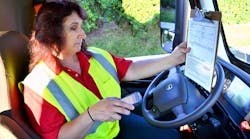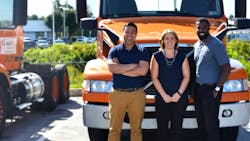Women driving heavy trucks in the United States is by no means unprecedented, nor is it new. Yet in a society where women make up about 51% of the population and an industry that's been crying "driver shortage, driver shortage" for years, only about one out of every 15 over-the-road truck drivers is a woman.
What's the problem?
There are certainly clues. Here's an exercise you can listen for in conversations lately: someone starts talking about their personal experiences or something they like to do, then someone else approvingly hits them back with, "Same," indicating their own similarity in a word.
It's about inclusion and sharing things in common. In Fleet Owner's conversations, that's something fleets have found has been lacking when it comes to women in trucking's ranks. And no one wants to be the oddball out, feeling isolated in their job or at the workplace.
Breaking the mold
A. Duie Pyle, a carrier providing truckload, less-than-truckload and logistics services in the Northeast, has made some strides in this regard. The company didn't set out by trying to bring in more women or diversity to its workforce, per se; the idea was to set up better succession planning and having the right person in each job, and Pyle started taking a different approach about seven years ago.
"Before, it was more of an 'ordained' person. They simply moved up a notch," said Randy Swart, chief operating officer at Pyle, describing the old system's rigidity. To change that, the company would identify and help prepare maybe three employees who could take over if another employee, perhaps a manager they reported to, left—whether it was a planned or unplanned transition.
"This allowed women to compete for jobs that they might not have competed for within our organization before, and be very successful at it," Swart noted. And as the organization indeed started seeing more women and diversity in its workforce, it became easier to add more.
"When it comes time to interview other women or show them that there are career paths within the organization—whether it be drivers or front-line supervisors, managers, directors and so on—that's really our theory as this has progressed," he explained. "If your organization reflects diversity from the top down, you'll be much more successful in attaining and securing different people in your front-line jobs, your driving jobs, your dock worker jobs, your fleet technicians, all those things.
“Because then they can see a career path and promotability," Swart continued. If Pyle were to hire a woman as a new customer service rep, for example, she might see male and female leaders in her department. Or the next level up might be a woman in marketing or a director of quality.
"There is nothing that would trigger in their mind, 'I've been hired into this organization and all it is is a male-dominated company," Swart pointed out.
Pyle has also taken the diversity message to heart in promotional materials used in the company's recruiting and outreach efforts. Women and minorities appear in those, "and it's really an inclusive package," according to Swart.
Along those lines, Garner Trucking, a truckload carrier and warehousing/ logistics provider based in Findlay, OH, is also sure to include women in its messaging. Sherri Garner-Brumbaugh, the company's president and CEO, noted in a roundtable discussion this month hosted by fleet management technology provider Omnitracs that she'd heard feedback from Garner's female truck drivers that women don't appear as truck drivers on billboards.
"Guess what we did?" she said. "We did a billboard of all my women in front of a truck along with myself, and we had that out there for a while and we've used that on our social media. It's just simple things like that—'I don't see myself out there, so it must not be a friendly industry for me.'"
That image issue—combating the thought that trucking and the businesses surrounding it are "a man's world," which has traditionally been the case and presumption—are also a major focus at Women in Trucking (WIT). During Omnitracs' roundtable discussion, WIT President and CEO Ellen Voie talked about the group's efforts to help update that image.
Those begin by reaching out to the next generation of youth. WIT has created a transportation patch for the Girl Scouts, an activity book for kids on the supply chain and trucks' role in that, and a truck driver doll called "Claire" that will be available at TA Petro truck stops and on Amazon.com, for instance.
"We want young girls to look at trucks and have a personal relationship with them," Voie said. The group also has an "image team" that helps spotlight women's role in trucking at media events and with legislators.
Yes, but...
For all these kinds of efforts to address trucking's image and make it more inclusive to women, it's still an uphill battle to attract women to the truck driver role specifically. WIT tracks the number of women working as over-the-road truck drivers, and the current figure is about 6-7% of the total.
Again, look at A. Duie Pyle, where women represent more than 50% of director-level management and the company seeks to foster a diverse workforce. Swart said the number of women driving the company's trucks remains stubbornly below that 6-7% mark, even as the company continues trying to bring on more.
And there's Garner, which is led by a woman and also promotes women as drivers and in other roles. Women work as the company's recruiter and retention manager. There, Garner-Brumbaugh noted in the roundtable discussion, "I have a little over 100 drivers, and I have four female drivers right now"—so that's a simple 4%.
Here's some further insight:
• Women may not want the truck driver job, as it stands. After all, it's hard enough getting men to fill available seats, and the driver shortage is nothing new. Both Swart and Garner-Brumbaugh alluded to the driver position's need for better work-life balance, since drivers can still be away from home for extended periods or keep difficult hours. In 2018, that may be putting off both genders somewhat, and younger workers in general.
• Anti-harassment policies can help, but drivers don't only work at your terminal. There's a zero-tolerance policy against sexual harassment at Garner Trucking: "This will provide an exit from our employment," Garner-Brumbaugh said. It's also part of the culture at Pyle, where "taking an aggressive stance many years ago on workplace diligence, making sure we had empathy within the workplace, and making sure that we had a harassment-free workplace has been very valuable to us," noted Swart.
"It doesn't matter what gender you are," he added. "That just lets you flourish."
Even if that's the culture at the office or the terminal, guess what—that's not the only environment in which the driver must work. "Sadly, sometimes [sexual harassment] could potentially come from the customer base, too," Garner-Brumbaugh said during the roundtable. "Our drivers face challenges when they're maybe coming into a shipping location or wherever they find themselves on the road."
Maybe that's a shipper or receiver that has one poorly kept restroom women won't want to use. Maybe it's a dimly lit truck stop that would make women feel uncomfortable, perhaps putting them at greater risk of sexual assault. Don't overlook the fact that truck drivers often have to take what they can get for parking—be they male or female—and if you're begging for a decent spot to stop, bit tough to be very choosy.
• Along those lines, women truck drivers don't feel particularly safe. Not surprisingly given the above, WIT interviewed women truck drivers and found they rated their safety an average of 4.4 on a scale of one to 10. "That means we have a lot of work to do to make sure that they feel safe at the loading dock or at the truck stops," Voie said.
• Technology can improve things in many ways. Women may be able to shift a manual transmission just as well as men, but adding automated manual or automatic transmissions to trucks has been cited over and over as a way to help bring women and younger drivers into the fold.
Whether you can drive a stick or not, driving a truck safely requires focus, and having a transmission that does the complicated shifting can allow the driver to focus more of his or her attention on the road. Voie pointed out that that potentially increased safety factor in trucks may help get women to drive your vehicles.
Also in the safety category, both Garner and Pyle noted their addition of collision-avoidance technology in trucks. In addition to its Class 8 power units, Pyle has added smaller Class 5 trucks to its fleet in part to help new drivers test out the role and transition to getting a commercial driver's license. WIT's Voie referenced trucking companies that use personal safety devices—press a button and the device can track your position, and someone contacts the driver to check if things are okay.
• Give some thought to your driver training options. One way to drive women off is to force them into an uncomfortable situation in driver training. Do they have the option to go out on the road with another female?
"We have an industry that wants to pretend that there's no difference in gender when you train," Voie contended. "I find it very difficult when you have a young female who has to go out with a male trainer in the cab of a truck for weeks at a time." Garner Trucking's female driver trainers help women coming on learn the ropes, so to speak, in terms of staying safe on the job and can help ease the new driver transition, Garner-Brumbaugh said.
• In an environment that often sees high rates of driver turnover, hiring women might help. Lauren Domnick, senior director of analytics and modeling at Omnitracs, said the company's data shows that women drivers tend to stick with a company more than men do, and they also typically have fewer preventable accidents.
"If we're looking at recruiting and safety and retention, women seem to be better candidates in that regard, so we'd encourage folks to reach out and bring more women into the organization," Domnick said.
That matches up with Pyle's experience with retention. "Once we've had women come to work and drive for us, we've been quite successful in retaining them," he told Fleet Owner. "That has not been our issue with women drivers; it's finding them."
• Women may respond to an "in" in trucking. WIT's Voie said that in the group's experience, many women truck drivers had some connection to the industry; they didn't necessarily come to it themselves.
"83% of the women in the industry came into trucking because of a family member or a friend," she said. "Typically, that means that a husband, a boyfriend, a dad, a brother has said, 'Hey, why don't you get your CDL and come out on the road with me?'"
• Forget 18 wheels for a minute; consider two. It's just an informal tip from WIT, but if you want to recruit women as truck drivers, try a biker rally.
Polling female drivers on the group's Facebook page, WIT found that nearly 80% of the respondents had a motorcycle license and owned a motorcycle or rode motorcycles. Consider that motorcycles not only are the most dangerous form of transportation, they also place the rider right over the engine or motor, creating a very different motor-machine-driver connection than passenger cars do.
"Those are the women who aren't afraid of engines, and they're not afraid of being in a male-dominated environment," Voie noted.
• Old perceptions die hard. Going back to the image of trucking needing some updating, Voie pointed out that women have been getting a message that either overlooks or excludes them from trucking for many years. That's going to take some time and effort to change.
"Women look at the industry as a very male-dominated industry, and they think that you need strength to drive a truck or mechanical skills or that it's dirty or they have to do a lot of lifting, unloading and things like that," she said. "They often feel they aren't qualified for this job."
Meanwhile, it's not just a perception that women would be getting such a message. Only about 4% of trucking companies are using women in their recruiting ads, Voie noted from a best practices study WIT conducted.
"That's just wrong," she said. "They're not even putting women in the ads or they're using terms that maybe will exclude women."





